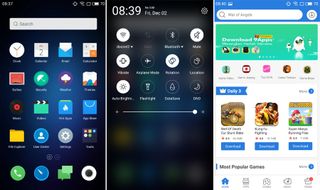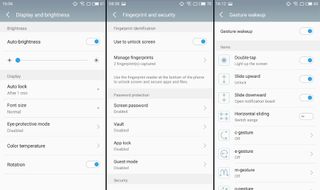Why you can trust TechRadar
Interface and reliability
- Unusual Android interface takes time to adapt to
- Google apps are missing, and take time to restore
- The interface is well-designed and fast
Pick up the Meizu M3 Max and you might be expecting a relatively straightforward Android experience with a fancy skin laid on top. What you actually get is version 5 of Meizu’s 'Flyme OS', which is most definitely based on Android 6.0 Marshmallow but has been skinned to within an inch of its life to more closely resemble Apple’s iOS.
Its proprietary home replacement launcher retains some similarities to Android: the notifications panel is accessed by dragging down from the top of the screen; you can add shortcuts, folders and widgets to the multiple home screen panels; and hidden behind the theme is a similar set of settings menus.
That is pretty much where the similarities end and the confusion begins. When you first boot up the phone you’re given a little explanation about the Flyme OS, then asked if you want to download the Google services in order to get access to the Play Store and all the apps and media it offers.

It seems a slightly unusual way of doing things, and may well be down to some kind of licensing agreement – or lack of – for prepackaging the phone with Google services in every country the M3 Max ships to.
After you've downloaded Google services and the Play Store app the device starts to feel a little more familiar, as you can download all the apps you'd expect to find on an Android handset – YouTube, Gmail, Maps etc.
Of course, you can choose to shun Google’s services entirely and go it alone with Meizu’s own app store – a Wild West affair of awkwardly renamed apps that look somewhat familiar, alongside apps that certainly look legitimate.
There’s also a 'Hot Apps' section, which enables you to download all the most commonly used apps such as WhatsApp, Instagram and, er, Pokemon Go. Downloads via this service were speedy and certainly seemed normal enough, although to be on the safe side we would certainly recommend that any apps you download be obtained through Google’s official Play store.

As far as navigating the Flyme OS is concerned, there isn’t the familiar three-button layout – back, home and app-switching – you’ll find on most Android phones; instead you get a single home button that takes you back to the home screen with a click, or acts as a back button with a tap.
It’s a nice idea, but in practice you often end up going back when you mean to simply go back to the home button. To bring up the multitasking screen you can swipe up from anywhere below the screen – a nifty solution that we only discovered by accident.
In many of the apps and settings screens, the default icon to return you to the previous screen is located all the way over at the top-left of the screen, which seems a world away from your thumb when the phone is held in one hand – this is most certainly a two-hand device.
Alternatively, you can enable the ‘SmartTouch’ floating widget that adds the much-needed navigation in an ever-present dot that can be tapped to go back, swiped left or right to switch between apps, and configured to do much more.
It can also be moved around the screen, so we chose to put it at the bottom left, to allow for easy control when using the phone in one hand.

Of course, the downside of this widget is that it can obscure text and other onscreen elements, so it’s not an ideal solution.
Like many other new Android handsets, the Meizu M3 Max recognises a variety of wake-up gestures: double-tap to wake; swipe up to unlock; swipe down to access notifications/settings. You can also add in custom gestures, which is a nice touch that makes it easier to launch straight into your most commonly-used apps.
Other unique features include an ‘Eye protective mode’, which works much like Apple's Night Shift mode, changing the colour temperature of the screen depending on the time of day and reducing the amount of blue light emitted to combat eye strain. A welcome feature indeed.
You can also independently adjust the colour temperature of the screen, to set it just right to suit your needs, whether you prefer your apps or media to have a warmer, cooler or more vibrant hue.
Benchmarks and performance
- Underwhelming benchmark scores don’t tell the whole story
- Despite the mid-range specs, everything runs very smoothly
Despite Meizu opting for cheaper silicon to power the M3 Max in the form of MediaTek’s 8-core Helio P10 processor, it's nigh-on impossible to tell the difference in day-to-day performance between this chip and more expensive options from Qualcomm.
Throughout our tests, apps launched quickly and ran without noticeable lag or slowdown, in a manner you'd expect from a considerably more expensive flagship device. Any games that we tried loaded quickly, ran without a hitch and looked great on the full HD screen. Our fingerprints were recognised instantly, waking the screen without delay.

In order to compare the performance of different smartphones we put every handset through the Geekbench 4 benchmark, which delivers scores based on single and multi-core performance. While benchmarks don’t necessarily reflect real-world performance, they still remain relevant for assessing raw performance.
With an average multi-core test score of 2718, the M3 Max achieved less than half the score returned by the similarly sized but significantly more expensive Huawei Mate 9, which returned a multi-score score of 5815.
Things weren’t much better in the single-core test, with the score of 684 reminiscent of the kinds of speeds seen on 2014 flagship smartphones.
Despite these somewhat lacklustre results, we would reiterate that these benchmark scores are not the be-all and end-all, and the overall performance we experienced on the M3 Max was very quick, without any noticeable slow-down.
Current page: What’s it like to use?
Prev Page Introduction, key features and design Next Page Battery life and camera
Wear OS 5: what we want to see, and all the leaks so far

The obscure little PC that wanted to be a big NAS — super compact Maiyunda M1 doesn't cost that much, offers up to 40TB SSD storage, runs Windows and has 4 Gigabit Ethernet ports

Image site Abload going offline reminds me of how much online content we've permanently lost
